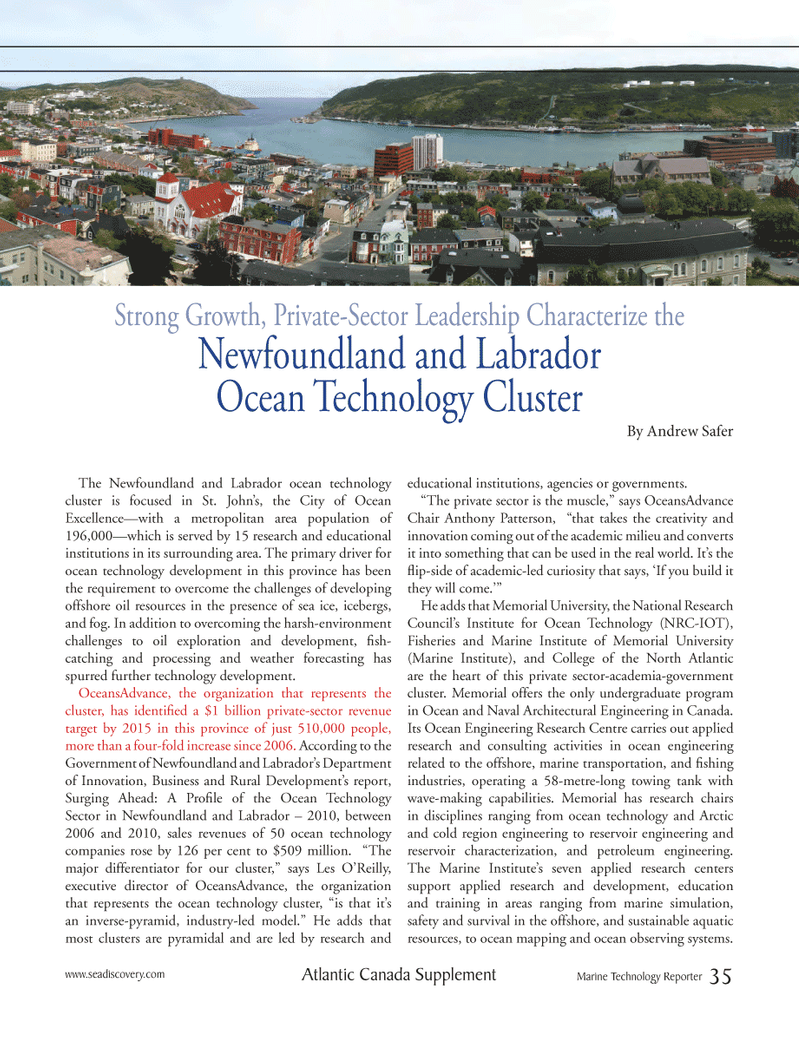
Page 35: of Marine Technology Magazine (March 2012)
Subsea Vehicle Report – Unmanned Underwater Systems
Read this page in Pdf, Flash or Html5 edition of March 2012 Marine Technology Magazine
Atlantic Canada Supplementwww.seadiscovery.com Marine Technology Reporter 35The Newfoundland and Labrador ocean technology cluster is focused in St. John?s, the City of Ocean Excellence?with a metropolitan area population of 196,000?which is served by 15 research and educational institutions in its surrounding area. The primary driver for ocean technology development in this province has been the requirement to overcome the challenges of developing offshore oil resources in the presence of sea ice, icebergs, and fog. In addition to overcoming the harsh-environment challenges to oil exploration and development, sh-catching and processing and weather forecasting has spurred further technology development. OceansAdvance, the organization that represents the cluster, has identi ed a $1 billion private-sector revenue target by 2015 in this province of just 510,000 people, more than a four-fold increase since 2006. According to the Government of Newfoundland and Labrador?s Department of Innovation, Business and Rural Development?s report, Surging Ahead: A Pro le of the Ocean Technology Sector in Newfoundland and Labrador ? 2010, between 2006 and 2010, sales revenues of 50 ocean technology companies rose by 126 per cent to $509 million. ?The major differentiator for our cluster,? says Les O?Reilly, executive director of OceansAdvance, the organization that represents the ocean technology cluster, ?is that it?s an inverse-pyramid, industry-led model.? He adds that most clusters are pyramidal and are led by research and educational institutions, agencies or governments. ?The private sector is the muscle,? says OceansAdvance Chair Anthony Patterson, ?that takes the creativity and innovation coming out of the academic milieu and converts it into something that can be used in the real world. It?s the ip-side of academic-led curiosity that says, ?If you build it they will come.?? He adds that Memorial University, the National Research Council?s Institute for Ocean Technology (NRC-IOT), Fisheries and Marine Institute of Memorial University (Marine Institute), and College of the North Atlantic are the heart of this private sector-academia-government cluster. Memorial offers the only undergraduate program in Ocean and Naval Architectural Engineering in Canada. Its Ocean Engineering Research Centre carries out applied research and consulting activities in ocean engineering related to the offshore, marine transportation, and shing industries, operating a 58-metre-long towing tank with wave-making capabilities. Memorial has research chairs in disciplines ranging from ocean technology and Arctic and cold region engineering to reservoir engineering and reservoir characterization, and petroleum engineering. The Marine Institute?s seven applied research centers support applied research and development, education and training in areas ranging from marine simulation, safety and survival in the offshore, and sustainable aquatic resources, to ocean mapping and ocean observing systems. Strong Growth, Private-Sector Leadership Characterize the Newfoundland and Labrador Ocean Technology Cluster By Andrew Safer MTR2 Canada Supplement 32-48.indd 35MTR2 Canada Supplement 32-48.indd 352/22/2012 3:07:50 PM2/22/2012 3:07:50 PM

 34
34

 36
36
